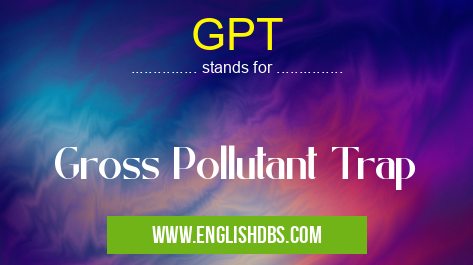What does GPT mean in ENVIRONMENTAL
GPT stands for Gross Pollutant Trap, a type of water management device used in stormwater management projects worldwide. This device is used to trap sediment, trash, debris and other pollutants which would otherwise find their way into our waterways and oceans. It collects gross pollutants from runoff before it reaches the waterbody, improving the overall water quality and helping to protect aquatic ecosystems. In addition, GPTs can also help reduce flooding by absorbing excess runoff during heavy rain events.

GPT meaning in Environmental in Governmental
GPT mostly used in an acronym Environmental in Category Governmental that means Gross Pollutant Trap
Shorthand: GPT,
Full Form: Gross Pollutant Trap
For more information of "Gross Pollutant Trap", see the section below.
Overview
A Gross Pollutant Trap is a large basin or tank that contains filter screens, weirs, baffles or other materials designed to capture trash and debris before they can enter streams, rivers or oceans. These traps can be located on land adjacent to water bodies or they may be placed directly within channels. They typically include an inlet channel where runoff enters the trap; a settling area which captures heavier particles like sediment; a sump or collection chamber where trapped material is retained; outlet pipes that convey clean outflow away from the trap; and often a manual cleanout port for periodic maintenance. GPTs are recognized as one of the most effective solutions available for controlling polluted runoff.
Purpose
The purpose of installing GPTs is threefold: firstly, they help maintain healthy aquatic ecosystems by trapping pollutants before they enter bodies of water; secondly, they reduce flooding by controlling stormwater flow during heavy rain events; and thirdly, they ensure compliance with regulations set out by governmental agencies such as the Environmental Protection Agency (EPA). By trapping sediments and harmful chemicals like fertilizers at their source rather than allowing them to disperse through natural drainage systems – i.e., rivers – GPTs offer an environmentally friendly approach for reducing pollution levels in rivers and streams.
Governmental Use
In many countries, governments require developers of new urban areas to install GPTs as part of their stormwater management plans due to the potential environmental impacts caused by increased run-off volumes after development has occurred. The EPA has published several guidelines on designing and installing Gross Pollutant Traps when constructed as stormwater detention ponds or wet ponds as part of green infrastructure best practices project manuals developed for local governments in various states across the US. In Australia too there are particular requirements specified by state governments related to Urban Stormwater Management Plans & Practices (USMPP) which include installation & maintenance of GPTs amongst other measures aimed at achieving improved water quality outcomes within catchments or drainage basins.
Essential Questions and Answers on Gross Pollutant Trap in "GOVERNMENTAL»ENVIRONMENTAL"
What is a Gross Pollutant Trap (GPT)?
A Gross Pollutant Trap (GPT) is a stormwater treatment system which removes debris such as plastic, sediment, and other pollutants from stormwater runoff. GPTs are designed to reduce the amount of pollutants entering our water bodies, improving the health of aquatic habitats and providing cleaner, healthier water for recreation.
What type of pollutants can GPTs capture?
GPTs are designed to capture larger pollutants such as plastics, leaves, sediment, litter, and other debris. They are not designed to capture dissolved pollutants such as nutrients or chemicals.
How does a GPT work?
A GPT works by trapping suspended solids in the stormwater runoff in its filter bed media. The filtered water flows through the media into collection chambers before it is discharged into rivers or streams.
Where is a GPT typically installed?
Typically, GPTs are installed at low points in drainage systems where they can catch debris before it flows downstream into waterways.
Are there different types of GPTs?
Yes. There are several different designs of GPTs depending on the size and type of pollution that needs to be removed from stormwater runoff. Some common types include sand filters, oil-grit separators and vortex separators.
How often should a GPT be serviced?
It depends on numerous factors including local weather patterns, surrounding areas that can contribute to an increase in pollutants discharged into the system, and how much rainfall your area receives each year. Generally speaking though most GPT’s should be serviced at least once per year or more if need be for optimal performance.
GPT also stands for: |
|
| All stands for GPT |
